Cubs hoping to defy odds in 2017 postseason
By George Castle For Chronicle Media — September 29, 2017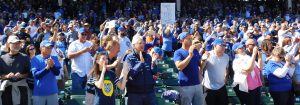
Cubs fans in back of the home dugout cheer their team during an on-field salute at Wrigley field Friday, Sept. 29 the Cubs first home appearance since winning their their second consecutive National League Central Division championship earlier in the week. (Photo by Jack McCarthy / Chronicle Media).
The Cubs share a lot of co-opponents with the Washington Nationals in their quest to repeat their 2016 World Series triumphs.
Most urgent is the near-sudden-death style of the five-game National League Division Series. The short playoff has been a 100-win team killer. Get a foe’s hot pitcher or two, a sudden clutch-hitting outage on your roster or a leaky bullpen, and you can easily be down 2-0 without only a quasi-miracle left to save you.
Those who survive the Division Series will face an endurance-and-intensity test in the seven-game National League Championship Series. Once increased to its present length, the LCS has proven to be more riveting, dramatic and heart-pounding than the World Series itself.

The video board says it all on Friday at Wrigley Field — the Cubs are division champions. The Cubs returned home to close the regular season against the Cincinnati Reds, opening a three-game weekend series at Wrigley Field. (Photo by Jack McCarthy / Chronicle Media).
Winning that, the prospective champion still has to win four more games as muscles and pitching arms go beyond their outer limits with the Fall Classic now lapsing into November.
The Cubs almost came up empty last year, having to defy odds in rallying from a 3-1 deficit inspite of questionable Joe Maddon handling of pitchers.
But the toughest obstacle is history itself. Repeat champions are few and far between in all sports.
In baseball, no NL team has won back-to-back World Series since the 1975-76 Cincinnati Reds.
The peak of the Big Red Machine was sublime. Some regarded the Pete Rose/Joe Morgan-led team the best in history. Only a Rick Monday running catch in right center with the bases loaded and two out in the ninth on June 15, 1975 to preserve a 4-3 win at Wrigley Field prevented the Reds from going 12-0 against the Cubs that season.
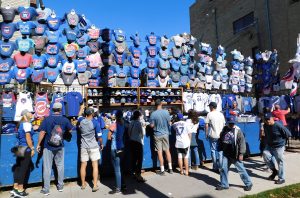
Dedicated Cubs fans had a large choice of tee-shirts, uniforms, hats and other Chicago Cubs materials outside the ballpark on Waveland Avenue prior to the Friday, Sept. 29 game against the Cincinnati Reds. (Photo by Jack McCarthy / Chronicle Media).
The dynastic Joe Torre-managed New York Yankees were the last MLB team, period, to repeat in 1999 and 2000. A wild last-of-the ninth Arizona Diamondbacks rally in Game 7 in the 9/11-delayed 2001 World Series prevented the Bronx Bombers from winning four Fall Classics in a row, proving again the extreme difficulty of repeating.
The 2005 White Sox were supposedly loaded in their repeat effort. General Manager Kenny Williams added slugger Jim Thome, who produced 42 homers, to balance out the lineup for 2006. But Peoria native Thome arrived from the Philadelphia Phillies at the cost of team leader/master center-field defender Aaron Rowand.
Rookie Brian Anderson proved not up to filling Rowand’s shoes in the outfield. Pitching mainstay Mark Buehrle had his first off season, while new rotation addition Javier Vazquez disappointed with an 11-12 record. The airtight bullpen of 2005 developed plenty of leaks.
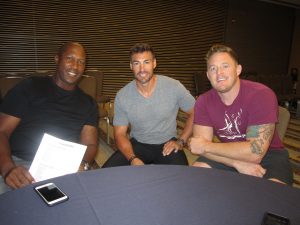
The 2006 Sox outfield (from left) Jermaine Dye, Scott Podsednik and Brian Anderson. Anderson could not replace Aaron Rowand’s defense and team leadership in center. (Photo by George Castle)
The same near-magical factors in 2005 simply could not be bottled a year later. The Sox began hot at 56-29 on July 6, but never actually led the AL Central after mid-May. A 10-15 July and 12-16 September put the eventual 90-win Sox out of the money, six games behind the division-winning Minnesota Twins and five in back of the wild-card Detroit Tigers. Taking a further edge off winning was manager Ozzie Guillen’s midseason suspension for a gay slur directed at critical Chicago Sun-Times columnist Jay Mariotti.
The ultimate Chicago repeat example, of course, are the double-threepeat Bulls of 1991-93 and 1996-98.
But the crucial factor is the NBA team never won a title without Michael Jordan. His Airness unexpectedly retired three months after the ’93 title, opting to play minor-league baseball for the Sox the following year. The 1994 Bulls gamely made the playoffs without Jordan, but were eliminated via several controversial calls in an emotional series against the archrival New York Knicks. Jordan returned too late in the 1994-95 season to be in prime form for the postseason. And Bulls management chose to intentionally break up the 1998 champions rather than allowing them to die a natural competitive death on court.

Cubs first baseman Anthony RIzzo greets a young fan and family prior the Friday, Sept. 29 home game against the Cincinnati Reds as the Cubs returned home as National League Central Division champions. (Photo by Jack McCarthy / Chronicle Media).
The most disappointing Chicago championship window, reverberating with regret to the present, is the 1985 Bears, still the most popular and dominating franchise in the city’s history.
In ’85, the Bears fielded perhaps the greatest NFL defense in history, allowing just 198 points in 16 games. Meanwhile, the Monsters defied their own tradition in leading the NFL in points with 456. Only a loss to the Miami Dolphins prevented a perfect regular season, the Bears ending 15-1 before three straight postseason triumphs, including Super Bowl XX, in which they allowed just 10 points total.
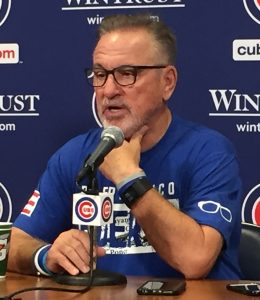
Cubs manager Joe Maddon talks playoff rotation and how he’ll approach the regular season’s final three games during a pre-game meeting with reporters last Friday. (Photo by Jack McCarthy / Chronicle Media)
Then, in 1986, the Bears defense actually outperformed its championship standard in allowing 187 points under a new defensive coordinator, Vince Tobin, replacing the popular Buddy Ryan. But an important offensive glue was lost when quarterback Jim McMahon, almost an assistant coach on the field, was deliberately mauled by Green Bay Packers lineman Charles Martin at Soldier Field on Nov. 23. After a stoppage of play, Martin grabbed McMahon and threw him down on his head. McMahon was out for the season after shoulder surgery. Diminutive Doug Flutie was signed as an emergency replacement — an unpopular move with Bears players. Although the team finished 14-2, they had no finishing kick in the playoffs, losing big to the Washington Redskins 27-13.
McMahon returned a diminished quarterback while the Bears’ rapport with coach Mike Ditka declined in future seasons. Parsimonious Bears management allowed key parts of the 1985 champions to depart rather than paying market salaries. With one exception, the Bears contended in every season through 1991, but the magic was gone.
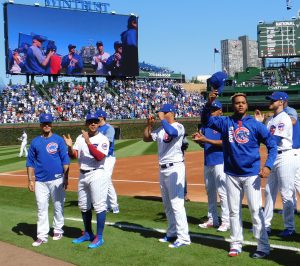
Chicago Cubs players gather along the third base line at Wrigley Field prior to last Friday’s game to tip their caps to fans as part of a celebration of their second consecutive National League Central Division championship. (Photo by Jack McCarthy / Chronicle Media).
Prior to the Cubs’ ascension, the most successful Chicago franchise has been the Blackhawks, breaking a 49-year title drought with a Stanley Cup title in 2010. The Hawks won two more Cups in lockout-shortened 2013 and 2015. But notice a trend — none of the titles were consecutive. The four-round playoff endurance test results in a short summer and crimps a team’s recovery time with negative effects on the next season.
The Hawks barely qualified for the postseason in 2011, then were knocked out in the first round. A lucky-bounce Los Angeles Kings’ overtime goal in Game 7 in 2014 prevented a repeat. And the St. Louis Blues finally beat the Hawks in the playoffs via a Game 7 first-round triumph in 2016.
So when the Cubs’ repeat chances are contemplated and a Chicago trail of postseason tears is recalled, the real feat will be a title this year, not the first time around in 2016.
—- Cubs hoping to defy odds in 2017 postseason —-



